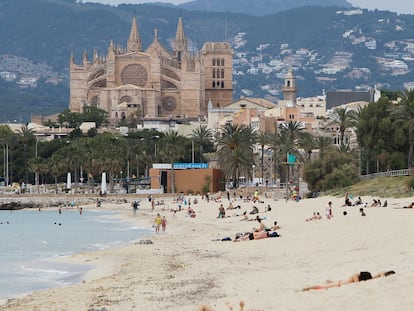European borders are reopening, but there is a lot of small print to digest
Travelers from EU and Schengen countries can enter Spain once more, but there are still a number of limits to free movement

After three months under a state of alarm, Spain lifted national travel restrictions at 12am on Sunday morning, and also reopened its borders to passengers from European Union and Schengen countries. But there are still a number of exceptions that limit free movement within these zones, and ongoing uncertainty regarding third countries.
From July 1, the Spanish government is planning to open the country’s borders to states where the coronavirus pandemic is under control, but for now there is no list of candidates. The administration is intending to accept a European pact on this list, but other EU states are already saying that they will take unilateral decisions on the matter.
From today, residents of Spain can travel to Sweden, located in the opposite extreme of Europe, but not Portugal, its neighbor, which will be keeping its borders closed to Spain and Italy until July 1.
Another country that borders Spain, France, will not reopen its borders until midnight tonight. Citizens from the United Kingdom, which has officially left the EU but is still covered by a transition agreement until December that grants it full rights as a member state, can enter Spain. But anyone taking the opposite journey will have to quarantine for two weeks on arrival in the UK, a measure that will be in place at least until June 29, despite Spain having opted not to impose a reciprocal measure on UK arrivals.
Another exception to the opening of borders for Schengen countries is Denmark, which will keep border controls in place for the majority of its fellow members – including Spain – until June 27.
While there are already a number of exceptions in Europe, the rules for non-EU and non-Schengen countries are yet to be defined at all. Spain is counting on the 27-member bloc to agree on a list of safe countries, with scaled entry dates according to the epidemiological situation in each one. Sources consulted from the Spanish Interior and Foreign ministries did not want to indicate which countries would be included, but did say that those citizens who would be permitted to enter from July 1 will be from the countries that are best controlling new coronavirus infections. “Japan and South Korea are not the same as Brazil,” the same sources said, citing cases from both extremes of the pandemic, and despite the fact that the former two countries have seen new outbreaks in recent weeks after initially limiting the impact of the pandemic.
Making a decision about the United States is particularly complex. While the management of the crisis by the Donald Trump administration has been very erratic, Europe has a huge interest in opening up its borders to that country. Before the pandemic struck, Spain received more than three million tourists a year from the US, and was among the top-10 destinations for US investment. But economic interests are coming up against two other principles: health and reciprocity. Washington is still vetoing the entrance of Europeans on American soil, which is prompting the EU to respond in kind.
Latin America is another key zone for Spain. During the state of alarm, a number of flights were authorized to allow Spanish residents who were trapped in countries such as Argentina, Colombia, Peru and Dominican Republic to return. But when it comes to reopening regular routes, the Spanish government is planning to wait for European consensus.
Despite the importance of these links for Spain, residents of Latin America, which is the new epicenter of the pandemic, could be among the last to be authorized to enter the European Union. There are, however, already loopholes. During the entire crisis, Portugal has allowed travelers in from Brazil, despite the latter being the second country to exceed a million Covid-19 cases, after the US.
While each member state will have the last word on its borders, Brussels insists that the 27 EU members should open up to third countries in a coordinated and progressive way, provided that they have an equal or better epidemiological situation. Among these, Brussels is pushing for the western Balkan countries – Albania, Bosnia, Kosovo, Montenegro, North Macedonia and Serbia – given their links with the EU and that they are considered to have controlled the spread of the virus.
The EU warns that announcements by certain partners, who are wiling to lift restrictions without consulting other states, are “threatening the integrity of the Schengen zone.” Greece is in the crosshairs, after having taken advantage of the tourist season to make a list of 29 countries that it considers to be safe and unilaterally signing a reopening of borders with Israel from August 1.
In the midst of pressure from the tourist sector to reopen borders, diplomatic sources are also uneasy over the reliability of coronavirus data from third countries, given that there are doubts over the veracity of the information they are supplying.
With just 10 days to go before July arrives, talks are stepping up. European ambassadors addressed the issue on Friday. “Now it is down to the member states to agree on a common list so that the travel restrictions can be lifted from July 1 onward,” EU sources said.
English version by Simon Hunter.









































